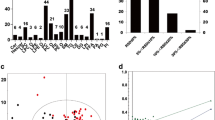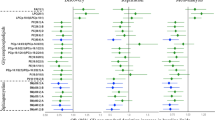Abstract
Disturbances in peripheral and brain lipid metabolism, including the omega-3 fatty acid docosahexaenoic acid (DHA), have been reported in major depressive disorder (MDD). However, these changes have yet to be confirmed in MDD with seasonal pattern (MDD-s), a subtype of recurrent MDD. The present exploratory study quantified plasma plasmalogen and diacyl-phospholipid species, and fatty acids within total phospholipids, cholesteryl esters, triacylglycerols and free fatty acids in non-medicated MDD-s participants (n = 9) during euthymia in summer or fall, and during depression in winter in order to screen for potential high sensitivity lipid biomarkers. Triacylglycerol alpha-linolenic acid concentration was significantly decreased, and myristoleic acid concentration was significantly increased, during winter depression compared to summer-fall euthymia. 1-stearyl-2-docosahexaenoyl-sn-glycero-3-phosphoethanolamine, a diacyl-phospholipid containing stearic acid and DHA, was significantly decreased in winter depression. Concentrations of cholesteryl ester oleic acid and several polyunsaturated fatty acids between summer/fall and winter increased in proportion to the increase in depressive symptoms. The observed changes in lipid metabolic pathways in winter-type MDD-s offer new promise for lipid biomarker development.


Similar content being viewed by others
Abbreviations
- ALA:
-
Alpha-linolenic acid
- ARA:
-
Arachidonic acid
- di-17:0 PC:
-
1,2-Diheptadecanoyl-sn-glycero-3-phosphocholine
- DHA:
-
Docosahexaenoic acid
- EDTA:
-
Ethylenediaminetetraacetic
- EPA:
-
Eicosapentaenoic acid
- LNA:
-
Linoleic acid
- LC–MS/MS:
-
Liquid chromatography tandem mass spectrometry
- MDD-s:
-
Major depressive disorder with seasonal pattern
- MRM:
-
Multiple reaction monitoring
- OLA:
-
Oleic acid
- PtdCho:
-
Phosphatidylcholine
- PUFA:
-
Polyunsaturated fatty acids
- STA-ARA-Gro-3-PCho:
-
1-Stearoyl-2-arachidonoyl -sn-glycero-3-phosphocholine
- STA-DHA-Gro-3-PCho:
-
1-Stearoyl-2-docosahexaenoyl-sn-glycero-3-phosphocholine
- STA-OLA-Gro-3-PCho:
-
1-Stearoyl-2-oleoyl-sn-glycero-3-phosphocholine
- STol-ARA-Gro-3-PCho:
-
1-(1Z-octadecenyl)-2-arachidonoyl-sn-glycero-3-phosphocholine
- STol-DHA-Gro-3-PCho:
-
1-(1Z-octadecenyl)-docosahexaenoyl-sn-glycero-3-phosphocholine
- STol-OLA-Gro-3-PCho:
-
1-(1Z-octadecenyl)-2-oleoyl-sn-glycero-3-phosphocholine
- PE:
-
Phosphatidylethanolamine
- STA-ARA-Gro-3-PEtn:
-
1-Stearoyl-2-arachidonoyl-sn-glycero-3-phosphoethanolamine
- STA-DHA-Gro-3-PEtn:
-
1-Stearoyl-2-docosahexaenoyl-sn-glycero-3-phosphoethanolamine
- STA-OLA-Gro-3-PEtn:
-
1-Stearoyl-2-oleoyl-sn-glycero-3-phosphoethanolamine
- STol-ARA-Gro-3-PEtn:
-
1-(1Z-octadecenyl)-arachidonoyl-sn-glycero-3-phosphoethanolamine
- STol-DHA-Gro-3-PEtn:
-
1-(1Z-octadecenyl)-docosahexaenoyl-sn-glycero-3-phosphoethanolamine
- STol-OLA-Gro-3-PEtn:
-
1-(1Z-octadecenyl)-oleoyl-sn-glycero-3-phosphoethanolamine
- RBC:
-
Red blood cells
- TLC:
-
Thin layer chromatography
References
Blazer DG, Kessler RC, Swartz MS (1998) Epidemiology of recurrent major and minor depression with a seasonal pattern. The National Comorbidity Survey. Br J Psychiatry 172:164–167
Levitt AJ, Boyle MH, Joffe RT, Baumal Z (2000) Estimated prevalence of the seasonal subtype of major depression in a Canadian community sample. Can J Psychiatry 45:650–654
Sun J, Guo X, Ma J, Zhang J, Jia C, Xu A (2011) Seasonality of suicide in Shandong China, 1991–2009: associations with gender, age, area and methods of suicide. J Affect Disord 135:258–266
Postolache TT, Mortensen PB, Tonelli LH, Jiao X, Frangakis C, Soriano JJ, Qin P (2010) Seasonal spring peaks of suicide in victims with and without prior history of hospitalization for mood disorders. J Affect Disord 121:88–93
Michalak EE, Tam EM, Manjunath CV, Levitt AJ, Levitan RD, Lam RW (2005) Quality of life in patients with seasonal affective disorder: summer vs winter scores. Can J Psychiatry 50:292–295
Westrin A, Lam RW (2007) Seasonal affective disorder: a clinical update. Ann Clin Psychiatry 19:239–246
Lam RW, Levitt AJ, Levitan RD, Enns MW, Morehouse R, Michalak EE, Tam EM (2006) The Can-SAD study: a randomized controlled trial of the effectiveness of light therapy and fluoxetine in patients with winter seasonal affective disorder. Am J Psychiatry 163:805–812
Edwards R, Peet M, Shay J, Horrobin D (1998) Omega-3 polyunsaturated fatty acid levels in the diet and in red blood cell membranes of depressed patients. J Affect Disord 48:149–155
Ellis FR, Sanders TA (1977) Long chain polyunsaturated fatty acids in endogenous depression. J Neurol Neurosurg Psychiatry 40:168–169
Fehily AM, Bowey OA, Ellis FR, Meade BW, Dickerson JW (1981) Plasma and erythrocyte membrane long chain polyunsaturated fatty acids in endogenous depression. Neurochem Int 3:37–42
Huan M, Hamazaki K, Sun Y, Itomura M, Liu H, Kang W, Watanabe S, Terasawa K, Hamazaki T (2004) Suicide attempt and n-3 fatty acid levels in red blood cells: a case control study in China. Biol Psychiatry 56:490–496
Maes M, Christophe A, Delanghe J, Altamura C, Neels H, Meltzer HY (1999) Lowered omega3 polyunsaturated fatty acids in serum phospholipids and cholesteryl esters of depressed patients. Psychiatry Res 85:275–291
Maes M, Smith R, Christophe A, Cosyns P, Desnyder R, Meltzer H (1996) Fatty acid composition in major depression: decreased omega 3 fractions in cholesteryl esters and increased C20: 4 omega 6/C20:5 omega 3 ratio in cholesteryl esters and phospholipids. J Affect Disord 38:35–46
Peet M, Murphy B, Shay J, Horrobin D (1998) Depletion of omega-3 fatty acid levels in red blood cell membranes of depressive patients. Biol Psychiatry 43:315–319
Rizzo AM, Corsetto PA, Montorfano G, Opizzi A, Faliva M, Giacosa A, Ricevuti G, Pelucchi C, Berra B, Rondanelli M (2012) Comparison between the AA/EPA ratio in depressed and non depressed elderly females: omega-3 fatty acid supplementation correlates with improved symptoms but does not change immunological parameters. Nutr J 11:82
Sublette ME, Segal-Isaacson CJ, Cooper TB, Fekri S, Vanegas N, Galfalvy HC, Oquendo MA, Mann JJ (2011) Validation of a food frequency questionnaire to assess intake of n-3 polyunsaturated fatty acids in subjects with and without major depressive disorder. J Am Diet Assoc 111(117–123):e111–e112
Vareka T, Vecka M, Jirak R, Tvrzicka E, Macasek J, Zak A, Zeman M (2012) Plasma fatty acid profile in depressive disorder resembles insulin resistance state. Neuro Endocrinol Lett 33(Suppl 2):83–86
Assies J, Pouwer F, Lok A, Mocking RJ, Bockting CL, Visser I, Abeling NG, Duran M, Schene AH (2010) Plasma and erythrocyte fatty acid patterns in patients with recurrent depression: a matched case-control study. PLoS One 5:e10635
Amin AA, Menon RA, Reid KJ, Harris WS, Spertus JA (2008) Acute coronary syndrome patients with depression have low blood cell membrane omega-3 fatty acid levels. Psychosom Med 70:856–862
Frasure-Smith N, Lesperance F, Julien P (2004) Major depression is associated with lower omega-3 fatty acid levels in patients with recent acute coronary syndromes. Biol Psychiatry 55:891–896
Feart C, Peuchant E, Letenneur L, Samieri C, Montagnier D, Fourrier-Reglat A, Barberger-Gateau P (2008) Plasma eicosapentaenoic acid is inversely associated with severity of depressive symptomatology in the elderly: data from the Bordeaux sample of the Three-City Study. Am J Clin Nutr 87:1156–1162
Tiemeier H, van Tuijl HR, Hofman A, Kiliaan AJ, Breteler MM (2003) Plasma fatty acid composition and depression are associated in the elderly: the Rotterdam Study. Am J Clin Nutr 78:40–46
Riemer S, Maes M, Christophe A, Rief W (2010) Lowered omega-3 PUFAs are related to major depression, but not to somatization syndrome. J Affect Disord 123:173–180
Aupperle RL, Denney DR, Lynch SG, Carlson SE, Sullivan DK (2008) Omega-3 fatty acids and multiple sclerosis: relationship to depression. J Behav Med 31:127–135
Rees AM, Austin MP, Owen C, Parker G (2009) Omega-3 deficiency associated with perinatal depression: case control study. Psychiatry Res 166:254–259
Lin PY, Huang SY, Su KP (2010) A meta-analytic review of polyunsaturated fatty acid compositions in patients with depression. Biol Psychiatry 68:140–147
McNamara RK, Jandacek R, Tso P, Dwivedi Y, Ren X, Pandey GN (2013) Lower docosahexaenoic acid concentrations in the postmortem prefrontal cortex of adult depressed suicide victims compared with controls without cardiovascular disease. J Psychiatr Res 47:1187–1191
De Vriese SR, Christophe AB, Maes M (2004) In humans, the seasonal variation in poly-unsaturated fatty acids is related to the seasonal variation in violent suicide and serotonergic markers of violent suicide. Prostaglandins Leukot Essent Fatty Acids 71:13–18
Zuijdgeest-van Leeuwen SD, Dagnelie PC, Rietveld T, van den Berg JW, Wilson JH (1999) Incorporation and washout of orally administered n-3 fatty acid ethyl esters in different plasma lipid fractions. Br J Nutr 82:481–488
Subbaiah PV, Kaufman D, Bagdade JD (1993) Incorporation of dietary n-3 fatty acids into molecular species of phosphatidyl choline and cholesteryl ester in normal human plasma. Am J Clin Nutr 58:360–368
Harris WS, Thomas RM (2010) Biological variability of blood omega-3 biomarkers. Clin Biochem 43:338–340
Brites P, Waterham HR, Wanders RJ (2004) Functions and biosynthesis of plasmalogens in health and disease. Biochim Biophys Acta 1636:219–231
Otoki Y, Nakagawa K, Kato S, Miyazawa T (2015) MS/MS and LC-MS/MS analysis of choline/ethanolamine plasmalogens via promotion of alkali metal adduct formation. J Chromatogr B Analyt Technol Biomed Life Sci 1004:85–92
Beck AT, Steer RA, Brown GK (1996) Manual for the Beck Depression Inventory-II. Psychological Corporation, San Antonio
Otoki Y, Kato S, Kimura F, Furukawa K, Yamashita S, Arai H, Miyazawa T, Nakagawa K (2017) Accurate quantitation of choline and ethanolamine plasmalogen molecular species in human plasma by liquid chromatography–tandem mass spectrometry. J Pharm Biomed Anal 134:77–85
Skipski VP, Good JJ, Barclay M, Reggio RB (1968) Quantitative analysis of simple lipid classes by thin-layer chromatography. Biochim Biophys Acta 152:10–19
DeMar JC Jr, Ma K, Bell JM, Rapoport SI (2004) Half-lives of docosahexaenoic acid in rat brain phospholipids are prolonged by 15 weeks of nutritional deprivation of n-3 polyunsaturated fatty acids. J Neurochem 91:1125–1137
Ichihara K, Fukubayashi Y (2010) Preparation of fatty acid methyl esters for gas-liquid chromatography. J Lipid Res 51:635–640
Hennebelle M, Otoki Y, Yang J, Hammock BD, Levitt AJ, Taha AY, Swardfager W (2017) Altered soluble epoxide hydrolase-derived oxylipins in patients with seasonal major depression: an exploratory study. Psychiatry Res 252:94–101
Stelmach-Mardas M, Kleiser C, Uzhova I, Penalvo JL, La Torre G, Palys W, Lojko D, Nimptsch K, Suwalska A, Linseisen J, Saulle R, Colamesta V, Boeing H (2016) Seasonality of food groups and total energy intake: a systematic review and meta-analysis. Eur J Clin Nutr 70:700–708
Brychta RJ, Arnardottir NY, Johannsson E, Wright EC, Eiriksdottir G, Gudnason V, Marinac CR, Davis M, Koster A, Caserotti P, Sveinsson T, Harris T, Chen KY (2016) Influence of day length and physical activity on sleep patterns in older icelandic men and women. J Clin Sleep Med 12:203–213
Thompson GR, Jadhav A, Nava M, Gotto AM Jr (1976) Effects of intravenous phospholipid on low density lipoprotein turnover in man. Eur J Clin Invest 6:241–248
Galli C, Sirtori CR, Mosconi C, Medini L, Gianfranceschi G, Vaccarino V, Scolastico C (1992) Prolonged retention of doubly labeled phosphatidylcholine in human plasma and erythrocytes after oral administration. Lipids 27:1005–1012
Stewart JW, Quitkin FM, Terman M, Terman JS (1990) Is seasonal affective disorder a variant of atypical depression? Differential response to light therapy. Psychiatry Res 33:121–128
Metherel AH, Domenichiello AF, Kitson AP, Hopperton KE, Bazinet RP (2016) Whole-body DHA synthesis-secretion kinetics from plasma eicosapentaenoic acid and alpha-linolenic acid in the free-living rat. Biochim Biophys Acta 1861:997–1004
Acknowledgements
WS and AYT conceived the idea of probing lipidomics in seasonal affective disorder patients. WS and AJL conceived the study design and implementation. KN and YO contributed the plasmalogen standards and method development. YO and MH performed the analysis. AYT and WS contributed to drafting the manuscript. All authors edited and approved the final version of the manuscript.
Author information
Authors and Affiliations
Corresponding author
Ethics declarations
Conflict of interest
The authors declare that they have no competing interest.
Ethical approval
The study was approved by the Sunnybrook Research Ethics Board and complied with ethical standards.
Funding
The authors acknowledge financial support from the UC Davis Department of Food Science and Technology and College of Agriculture and Environmental Sciences, Sunnybrook Health Sciences Centre Department of Psychiatry and Sunnybrook Research Institute Hurvitz Brain Sciences Program.
Electronic supplementary material
Below is the link to the electronic supplementary material.
About this article
Cite this article
Otoki, Y., Hennebelle, M., Levitt, A.J. et al. Plasma Phosphatidylethanolamine and Triacylglycerol Fatty Acid Concentrations are Altered in Major Depressive Disorder Patients with Seasonal Pattern. Lipids 52, 559–571 (2017). https://doi.org/10.1007/s11745-017-4254-1
Received:
Accepted:
Published:
Issue Date:
DOI: https://doi.org/10.1007/s11745-017-4254-1




